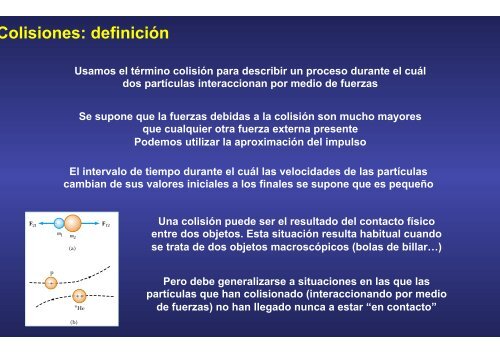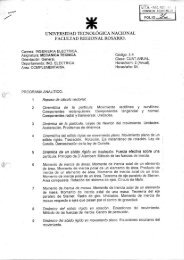7.Momento_lineal_y_colisiones
Create successful ePaper yourself
Turn your PDF publications into a flip-book with our unique Google optimized e-Paper software.
260 C HAPTER 9 • Linear Momentum and Collisions<br />
olisiones: definición<br />
2.64 Usamos 10 4 move away from the wall at 2.60 m/s after the collision. If<br />
î kgel m/stérmino colisión para describir un proceso durante el cuál<br />
the car does not rebound, the force is only doing the first of<br />
dos partículas interaccionan these, stopping the car. por This medio will require de a smaller fuerzas force.<br />
The average force exerted by the wall on the car is<br />
F p<br />
t<br />
I p p f p i 0.39 10 4 î kg m/s<br />
I <br />
( 2.25 10 4 î kgm/s)<br />
2.64 104 î kgm/s<br />
<br />
0.150 s<br />
1.76 10 5 î N<br />
I p p<br />
Se supone que la fuerzas debidas a f p<br />
la colisión i 0 (2.25 10<br />
son 4 î kgm/s)<br />
mucho mayores<br />
2.25 10<br />
que cualquier otra fuerza externa presente<br />
4 î kgm/s<br />
The average force exerted by the wall on the car is<br />
Podemos utilizar la aproximación del impulso<br />
In this problem, note that the signs of the velocities indicate<br />
the reversal of directions. What would the mathematics be<br />
describing if both the initial and final velocities had the<br />
same sign?<br />
What If? What if the car did not rebound from the wall?<br />
Suppose the final velocity of the car is zero and the time interval<br />
of the collision remains at 0.150 s. Would this represent<br />
a larger or a smaller force by the wall on the car?<br />
Answer In the original situation in which the car rebounds,<br />
the force by the wall on the car does two things in<br />
the time interval—it (1) stops the car and (2) causes it to<br />
Mathematically, in the case of the car that does not rebound,<br />
the impulse is<br />
F p<br />
t<br />
2.25 104 î kgm/s<br />
0.150 s<br />
1.50 10 5 î N<br />
El intervalo de tiempo durante el cuál las velocidades de las partículas<br />
which is indeed smaller than the previously calculated value,<br />
cambian de sus valores iniciales as we argued a los conceptually. finales se supone que es pequeño<br />
F 21<br />
m 1 m 2<br />
(a)<br />
p<br />
+<br />
++<br />
4He<br />
(b)<br />
F 12<br />
Figure 9.7 (a) The collision between<br />
two objects as the result of<br />
direct contact. (b) The “collision”<br />
9.3 Collisions Una colisión in One puede Dimension ser el resultado del contacto físico<br />
In this entre section we dos use the objetos. law of conservation Esta situación of linear momentum resulta to describe habitual what cuando<br />
happens<br />
se<br />
when<br />
trata<br />
two particles<br />
de dos<br />
collide.<br />
objetos<br />
We use the<br />
macroscópicos<br />
term collision to represent<br />
(bolas<br />
an eventde billar…)<br />
during which two particles come close to each other and interact by means of forces.<br />
The time interval during which the velocities of the particles change from initial to final<br />
values is assumed to be short. The interaction forces are assumed to be much<br />
greater than any external forces present, so we can use the impulse approximation.<br />
Pero debe generalizarse a situaciones en las que las<br />
partículas que han colisionado (interaccionando por medio<br />
de fuerzas) no han llegado nunca a estar “en contacto”<br />
A collision may involve physical contact between two macroscopic objects, as described<br />
in Figure 9.7a, but the notion of what we mean by collision must be generalized<br />
because “physical contact” on a submicroscopic scale is ill-defined and hence meaningless.<br />
To understand this, consider a collision on an atomic scale (Fig. 9.7b), such as the<br />
collision of a proton with an alpha particle (the nucleus of a helium atom). Because the<br />
particles are both positively charged, they repel each other due to the strong electrostatic<br />
force between them at close separations and never come into “physical contact.”<br />
When two particles of masses m 1 and m 2 collide as shown in Figure 9.7, the impul-




